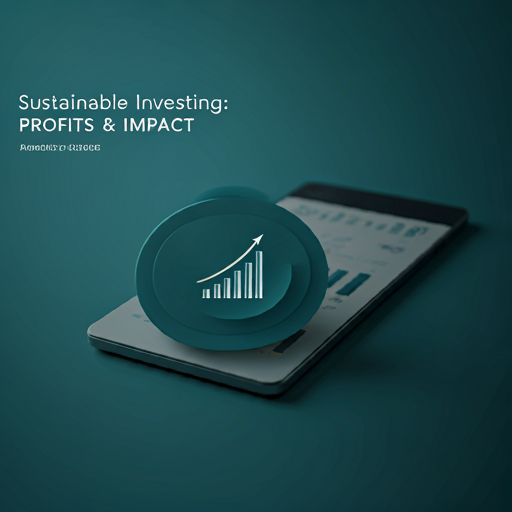Sustainable Investing: Balancing Profits and Environmental Impact
Definition and Importance
Sustainable investing refers to the integration of environmental, social, and
Historical Context and Evolution
The concept of sustainable investing has evolved significantly since its inception in the 1960s. Initially, it focused primarily on negative screening, where investors excluded companies involved in harmful practices. This approach laid the groundwork for a more nuanced understanding of investment impacts. Today, sustainable investing encompasses a broader spectrum, including positive screening and impact investing. It aims to generate measurable social and environmental benefits alongside financial returns. This shift reflects a growing recognition of the interconnectedness of financial markets and global challenges. Investors are increasingly aware of their influence. They can drive change through their capital allocation.
The Role of Cryptocurrency in Sustainable Investing
How Cryptocurrencies Can Support Sustainability
Cryptocurrencies can play a pivotal role in promoting sustainability through innovative financial mechanisms. For instance, blockchain technology enables transparent tracking of carbon credits and renewable energy certificates. This transparency fosters trust among stakeholders and encourages investment in sustainable projects. Additionally, decentralized finance (DeFi) platforms can facilitate funding for green initiatives without traditional banking barriers. This democratization of finance empowers individuals and organizations to support eco-friendly ventures. Moreover, certain cryptocurrencies are designed to minimize energy consumption, addressing concerns about the environmental impact of mining. This shift towards energy-efficient protocols is crucial. It reflects a commitment to sustainability in the crypto space.
Challenges and Criticisms of Crypto Sustainability
Despite the potential benefits, cryptocurrencies face significant challenges regarding sustainability. One major concern is the high energy consumption associated with proof-of-work mining. This process often relies on fossil fuels, raising questions about its environmental impact. Many investors are increasingly aware of this issue.
Evaluating Sustainable Cryptocurrencies
Criteria for Assessment
When evaluating sustainable cryptocurrencies, several criteria are essential for assessment. First, the energy consumption of the blockchain network must be analyzed. Lower energy usage indicates a commitment to sustainability. Additionally, the project’s governance structure should promote transparency and accountability. This fosters trust among investors and stakeholders. Another vital factor is the alignment of the cryptocurrency’s mission with environmental goals. Projects that actively support renewable energy or carbon offset initiatives are more favorable. Furthermore, the community engagement and social impact of the cryptocurrency should be considered. A strong community can drive positive change. These criteria provide a comprehensive framework for informed investment decisions.
Case Studies of Sustainable Cryptocurrencies
Several cryptocurrencies exemplify sustainable practices through innovative approaches. For instance, Cardano employs a proof-of-stake consensus mechanism, significantly reducing energy consumption compared to traditional proof-of-work systems. This efficiency aligns with environmental sustainability goals. Another example is SolarCoin, which incentivizes solar energy production by rewarding users with tokens for generating solar power. This model directly supports renewable energy initiatives. Additionally, Algorand focuses on carbon neutrality by offsetting its emissions through various environmental projects. Such initiatives demonstrate a commitment to sustainability. Investors are increasingly drawn to these projects. They recognize the potential for both financial returns and positive environmental impact.
Strategies for Sustainable Investment in Cryptocurrency
Diversification and Risk Management
Effective diversification and risk management are crucial for sustainable investment in cryptocurrency. Investors should consider a multi-faceted approach that includes various asset classes. For example, a balanced portfolio might consist of:
This strategy mitigates risks associated with market volatility. Additionally, investors should regularly assess their portfolio’s performance. This can involve reallocating assets based on market trends and sustainability criteria. Furthermore, employing stop-loss orders can protect against significant downturns. Such measures enhance overall investment resilience. Investors must remain informed about market developments. Staying updated is essential for making sound decisions.
Long-term vs. Short-term Investment Approaches
Investors in cryptocurrency must choose between long-term and short-term strategies. Long-term investment typically involves holding assets for several years. This approach allows investors to benefit from market growth and technological advancements. He believes patience is key. In contrast, short-term investment focuses on quick gains through trading. This method requires constant market monitoring and analysis. It can be risky and stressful.
Both strategies have their merits. Long-term investors often experience less volatility. They can ride out market fluctuations. Short-term investors may capitalize on rapid price movements. However, they face higher transaction costs. Ultimately, the choice depends on individual risk tolerance and investment goals. Each investor should assess their financial situation carefully.
The Future of Sustainable Investing in the Crypto Space
Emerging Trends and Technologies
The future pf sustainable investing in the crypto space is shaped by emerging trends and technologies. One significant trend is the rise of decentralized finance (DeFi), which promotes financial inclusion and transparency. He sees great potential here. Additionally, the integration of artificial intelligence can enhance investment strategies by analyzing vast data sets. This capability allows for more informed decision-making.
Another noteworthy development is the increasing focus on carbon-neutral cryptocurrencies. Projects that prioritize sustainability are gaining traction among investors. They recognize the importance of environmental responsibility. Furthermore, regulatory frameworks are evolving to support sustainable practices in the crypto industry. This shift encourages responsible innovation. Investors must stay informed about these trends. Awareness is crucial for making strategic investment choices.
Regulatory Considerations and Market Dynamics
Regulatory considerations play a crucial role in shaping the future of sustainable investing in the crypto space. Governments are increasingly focusing on establishing frameworks that promote transparency and accountability. This shift can enhance investor confidence. He believes regulations will evolve. Additionally, market dynamics are influenced by the growing demand for environmentally responsible investments. Investors are seeking assets that array with their values.
Furthermore, regulatory compliance can drive innovation in sustainable technologies. Companies that prioritize sustainability may gain a competitive edge. This trend is evident in the rise of green cryptocurrencies. These assets appeal to socially conscious investors. As regulations become more defined, the market will likely stabilize. Investors must remain vigilant about these changes. Awareness is essential for strategic decision-making.

Leave a Reply